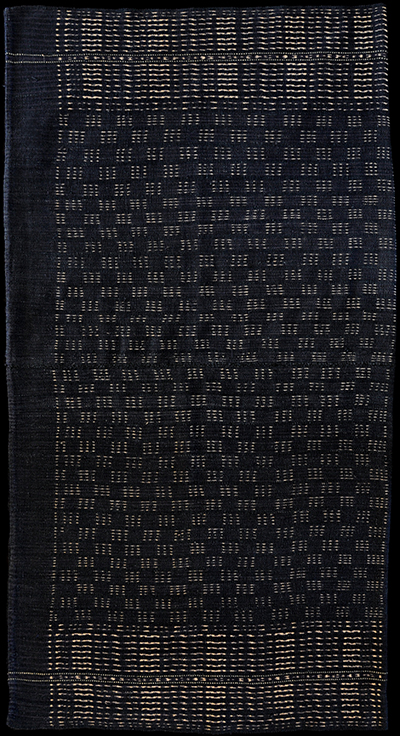| |
 
 | | | |
211 Flores Group, Peninsula
Kewatek (sarong)  
| | Locale: | Ili Mandiri. | | Period: | 1945 or before | | Yarn: | Cotton, hand-spun, medium | | Technique: | Warp ikat | | Panels: | 2 | | Size: | 68 x 128 cm (2' 2" x 4' 2") LW: 1.88 | | Weight: | 755 g (26.6 oz), 434 g/m2 (1.42 oz/ft2) | | Design: | Checkered field with white squares, built up of parallel lines, on dark indigo field. Wide borders consisting of horizontal line and squiggels grouped into bands. The name miten means black, but in much of Flores indigo is so named as well. In this case the name is truly apt as the indigo actually is nearly black. | | Comment: | Kewatek kenirek miten, sarong for daily use. Paradoxically, though this is the most common type of Ili Mandiri, intended for daily, non-ceremonial use, it is among the hardest to find - at least in good condition. The reason is that these were never treasured by the local population, hence not offered for sale to treasure hunters, nor much sought after by collectors. As a result most were simply worn till they were little more than shreds. (See image below of laundered working day sarongs on nearby Lembata, hung out to dry.) The value of kewatek kenirek miten now approaches that of kewatek méan bridewealth sarongs. A few small old repairs on one side, otherwise in fine condition. | | Background: | Chapters on Flores Group and Peninsula. | | Exhibited: | Hong Kong University Museum and Art Gallery, 2017. | | Published: | Ikat Textiles of the Indonesian Archipelago, 2018.
| | Compare: | 007 097 128 | | Sources: | Nearly identical to 1940 kewatek kenirek miten in Khan Majlis, Woven Messages, Fig. 177. Similar to example from August Flick collection depicted in Hamilton, Gift of the Cotton Maiden, Fig.8-6. Similar to sarong in Barnes and Hunt Kahlenberg, Five Centuries of Indonesian Textiles, p. 330. The motif is intriguingly similar to a Tanimbarese motif shown in Van Vuuren, Ikat from Tanimbar, Fig. 18b. | | |

©Peter ten Hoopen, 2025
All rights reserved.
|
|


